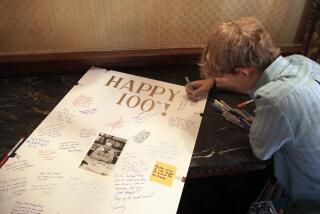R.M. Eakin; Professor Depicted Famed Scientists
- Share via
Former UC Berkeley zoology department Chairman Richard Marshall Eakin worried that his basic lecture course in general biology could put his students to sleep. Stamens and pistils and bacilli and blood circulation and the migration of beetles, he knew, did not top collegians’ list of fascinating topics. Absenteeism ran rampant.
So one day in 1970, he walked into his Zoology 10 class dressed in the Elizabethan garb of William Harvey, the discoverer of the circulation of blood. Aided by a professional makeup artist, coaching from a retired drama professor and the props of a cow’s heart and tomato juice for blood, Eakin explained in stilted Elizabethan English how Harvey proved that blood was moved through the body by the heart acting as a pump.
His students gave him a standing ovation.
For the next two decades, well beyond his official retirement in 1977, Eakin enthralled standing-room-only classes with lectures by Charles Darwin, the father of evolution; Gregor Mendel, the 19th century German monk who devised Mendel’s law of heredity; pre-Civil War surgeon William Beaumont, who explained the workings of the stomach; Hans Spemann, the embryologist; and Louis Pasteur, who taught the world to make milk safe by “pasteurizing” it.
“There’s a lot of ham in me,” Eakin once said. “Perhaps I am nothing more than a frustrated actor.”
His final lecture in 1988, delivered in the guise of Pasteur, drew 350 people.
Generations of premed students and fellow faculty still revere the innovative teacher who died Nov. 25 at his home in Danville, Calif., at the age of 89.
“If I, acting as the professor, tell them the facts, I can impart knowledge,” Eakin told the San Francisco Chronicle in 1975, discussing his unusual approach to students. “But when people of science come before them and use the same words, they have more meaning.”
Eakin’s techniques earned national attention with a feature in Life magazine, and he filmed his lectures for use by other educational groups.
He made guest appearances at other universities and gathered his lectures into a book, “Great Scientists Speak Again,” published by UC Press in 1975. Included were his introductory remarks for each lecture, his insights into the construction of the characters, and several photographs of him as the famous scientists with their visual aids.
“Prof. Eakin’s alchemy of theater, history and biology has brought forth golden moments for the lucky Berkeley students who attend his courses,” wrote author Keith S. Felton in reviewing the book for The Times in 1975. “With today’s education so dismayingly consonant with computer printout test results and professorial worries of research and publication, Richard Eakin has done more than enliven his Zoology 10 classes; he has made a great stride toward revivifying fundamental pedagogical values in his chosen profession. This volume ably charts his unique experiment in education.”
Eakin was an outstanding teacher even before he employed theatrics as a teaching tool. In 1962, he received Berkeley’s first citation for distinguished teaching, and in 1968 he won the award for outstanding teaching from the Associated Students of UC.
Also renowned as a zoologist, he was elected president of the American Society of Zoologists in 1975 and of the Western Society of Naturalists in 1949. A fellow of the California Academy of Sciences for 52 years, he published more than 200 scientific papers and several books and earned such awards as a 1953 Guggenheim Fellowship and in 1976 the Boston Museum of Science’s Walker Prize.
Eakin was widely respected for his research on the eyes of animals, particularly the so-called “third eye,” an organ that appears to be an eye but develops into the pineal gland in lizards and frogs. His other research included the structure of light-sensitive organs, amphibian embryology and transplants of animal organs and tissue.
Born in Florence, Colo., Eakin attended the University of Tulsa for two years and then transferred to Berkeley, where he earned a bachelor’s and doctorate in zoology and immediately joined the faculty. He chaired the department of zoology from 1942 to 1948 and again from 1953 to 1957, and was assistant dean of the College of Letters and Science from 1940 to 1943.
Eakin also co-authored a history published earlier this year of the 125-year-old First Congregational Church of Berkeley.
Widowed in 1980 by the death of his first wife, Mary, Eakin is survived by his second wife, cell biologist Barbara Nichols Eakin; a son, David Eakin of Richmond, Calif.; a daughter, Dottie Eakin of College Station, Texas; and two stepdaughters, Janet Harris of Sebastopol, Calif., and Jeannie Lamb of Bozeman, Mont.
UC officials said memorial contributions may be sent to Save Mount Diablo, P.O. Box 5376, Walnut Creek, Calif. 94596; California Academy of Sciences, Golden Gate Park, San Francisco, Calif. 94118, or to the San Francisco Symphony, Davies Symphony Hall, 201 Van Ness Ave., San Francisco, Calif. 94102.
More to Read
Sign up for Essential California
The most important California stories and recommendations in your inbox every morning.
You may occasionally receive promotional content from the Los Angeles Times.










